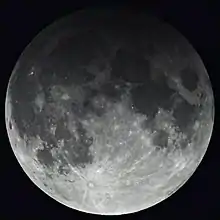| Total eclipse | |||||||||||||||||
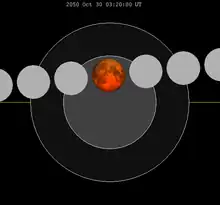 | |||||||||||||||||
| Date | 30 October 2050 | ||||||||||||||||
|---|---|---|---|---|---|---|---|---|---|---|---|---|---|---|---|---|---|
| Gamma | 0.4435 | ||||||||||||||||
| Magnitude | 1.0538[1] | ||||||||||||||||
| Saros cycle | 127 (44 of 72[2]) | ||||||||||||||||
| Totality | 34 minutes 30 seconds | ||||||||||||||||
| Partiality | 192 minutes 51 seconds | ||||||||||||||||
| Penumbral | 313 minutes 8 seconds | ||||||||||||||||
| |||||||||||||||||
A total lunar eclipse will take place on October 30, 2050.
This will be the second lunar eclipse in the 2050–2051 tetrad. Taking place near perigee, the Moon's apparent diameter will be larger.
Visibility
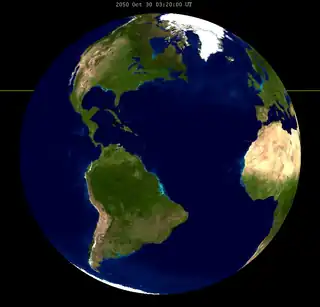
Related lunar eclipses
Lunar year series
| Ascending node | Descending node | |||||
|---|---|---|---|---|---|---|
| Saros | Date Viewing |
Type Chart |
Saros | Date Viewing |
Type Chart | |
| 112 | 2049 May 17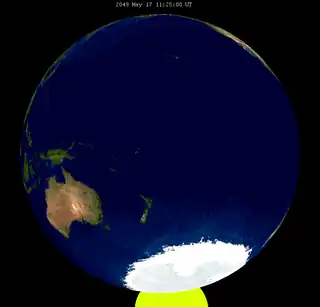 |
Penumbral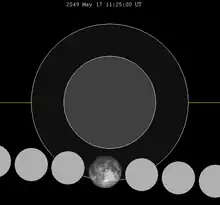 |
117 | 2049 Nov 09 |
Penumbral | |
| 122 | 2050 May 06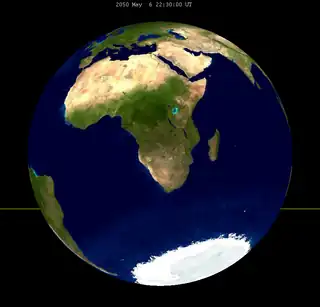 |
Total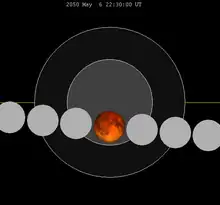 |
127 | 2050 Oct 30 |
Total | |
| 132 | 2051 Apr 26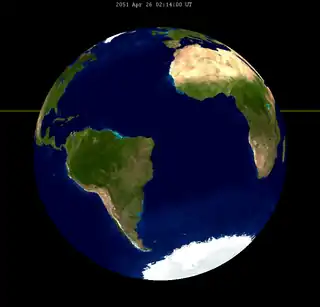 |
Total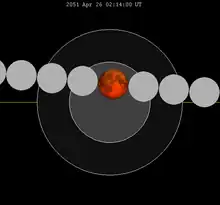 |
137 | 2051 Oct 19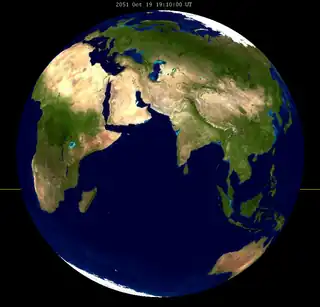 |
Total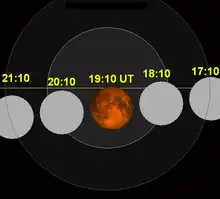 | |
| 142 | 2052 Apr 14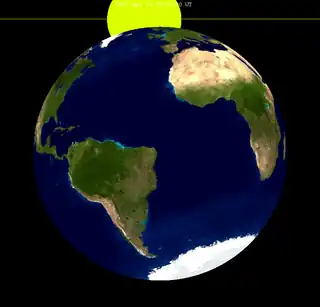 |
Penumbral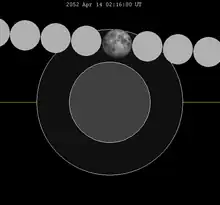 |
147 | 2052 Oct 08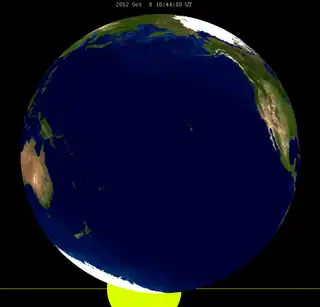 |
Partial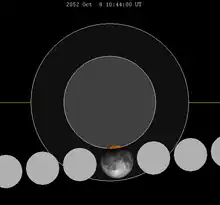 | |
| Last set | 2049 Jun 15 | Last set | 2048 Dec 20 | |||
| Next set | 2053 Aug 29 | Next set | 2053 Mar 04 | |||
Half-Saros cycle
A lunar eclipse will be preceded and followed by solar eclipses by 9 years and 5.5 days (a half saros).[3] This lunar eclipse is related to two annular solar eclipses of Solar Saros 134.
| October 25, 2041 | November 5, 2059 |
|---|---|
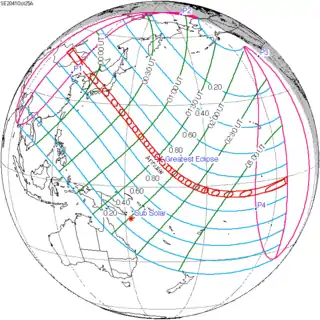 |
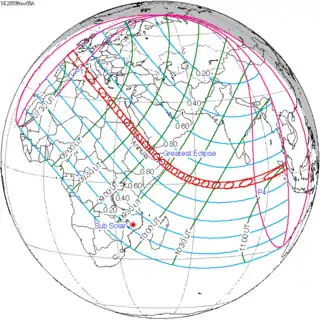 |
Saros series
Lunar saros series 127, repeating every 18 years and 11 days, has a total of 72 lunar eclipse events including 54 umbral lunar eclipses (38 partial lunar eclipses and 16 total lunar eclipses). Solar Saros 134 interleaves with this lunar saros with an event occurring every 9 years 5 days alternating between each saros series.
| Greatest | First | |||
|---|---|---|---|---|
The greatest eclipse of the series occurred on 1888 Jul 23, lasting 102 minutes. |
Penumbral | Partial | Total | Central |
| 1275 Jul 09 | 1473 Nov 04 | 1798 May 29 | 1834 Jun 21 | |
| Last | ||||
| Central | Total | Partial | Penumbral | |
1960 Sep 05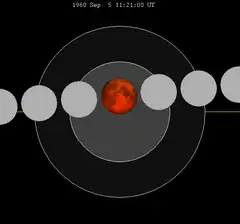 |
2068 Nov 09 | 2429 Jun 17 | 2555 Sep 02 | |
| 1906 Aug 04 | 1924 Aug 14 | 1942 Aug 26 | |||
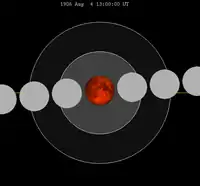 |
 |
 |
 |
 |
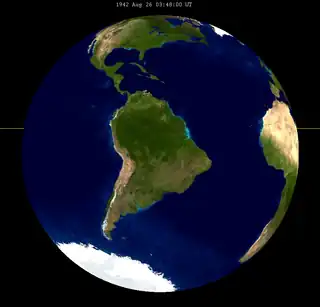 |
| 1960 Sep 05 | 1978 Sep 16 | 1996 Sep 27 | |||
 |
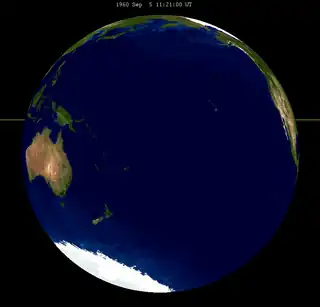 |
 |
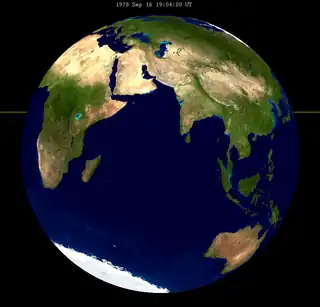 |
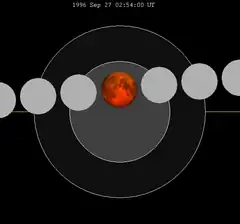 |
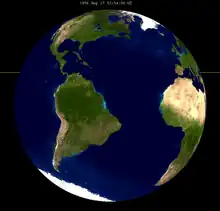 |
| 2014 Oct 08 | 2032 Oct 18 | 2050 Oct 30 | |||
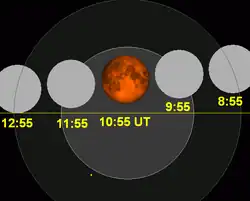 |
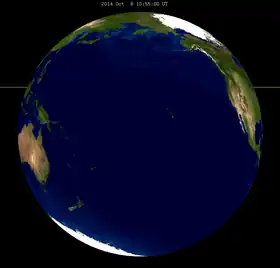 |
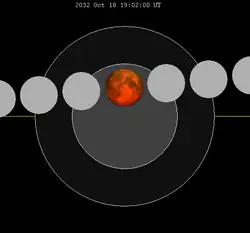 |
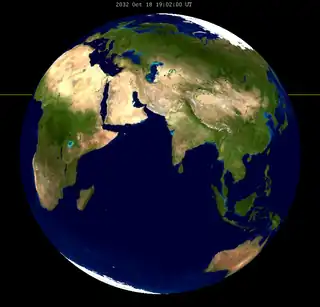 |
 |
 |
| 2068 Nov 09 | |||||
 |
 | ||||
See also
Notes
- ↑ For a partial or total lunar eclipse, this value denotes the umbral magnitude. For a penumbral lunar eclipse, this denotes the penumbral magnitude.
- ↑ Lunar Saros 127 - Fred Espenak's GSFC Eclipse Canon
- ↑ Mathematical Astronomy Morsels, Jean Meeus, p.110, Chapter 18, The half-saros
External links
- 2050 Oct 30 chart: Eclipse Predictions by Fred Espenak, NASA/GSFC
This article is issued from Wikipedia. The text is licensed under Creative Commons - Attribution - Sharealike. Additional terms may apply for the media files.
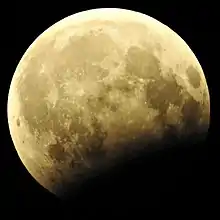
_(cropped).jpg.webp)
